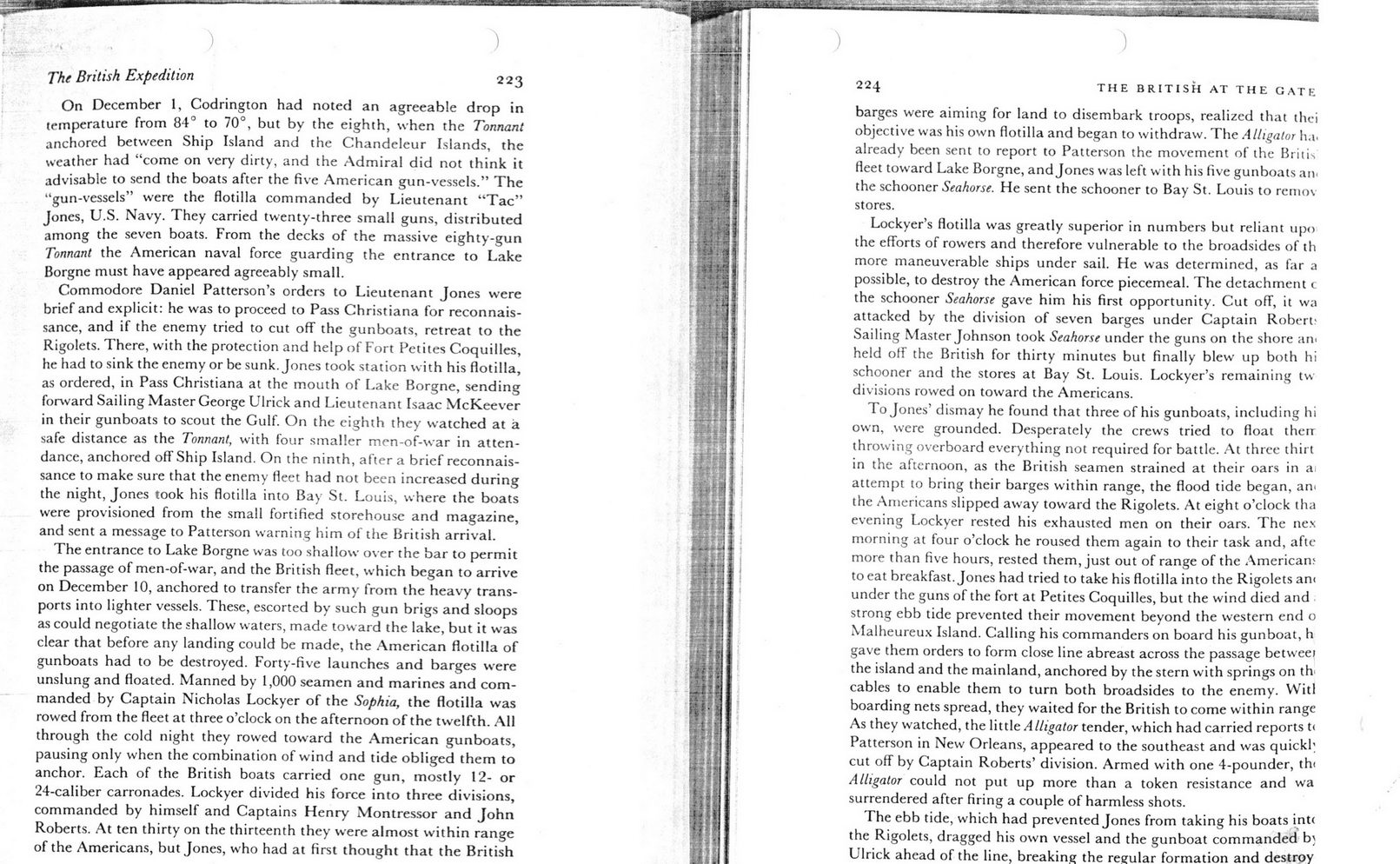This text was obtained via automated optical character recognition.
It has not been edited and may therefore contain several errors.
The British Expedition 223 On December 1, Codrington had noted an agreeable drop in temperature from 84? to 70?, but by the eighth, when the Tonnant anchored between Ship Island and the Chandeleur Islands, the weather had ?come on very dirty, and the Admiral did not think it advisable to send the boats after the five American gun-vessels.? The ?gun-vessels? were the flotilla commanded by Lieutenant ?Tac? Jones, U.S. Navy. They carried twenty-three small guns, distributed among the seven boats. From the decks of the massive eighty-gun Tonnant the American naval force guarding the entrance to Lake Borgne must have appeared agreeably small. Commodore Daniel Patterson?s orders to Lieutenant Jones were brief and explicit: he was to proceed to Pass Christiana for reconnaissance, and if the enemy tried to cut off the gunboats, retreat to the Rigolets. There, with the protection and help of Fort Petites Coquilles, he had to sink the enemy or be sunk. Jones took station with his flotilla, as ordered, in Pass Christiana at the mouth of Lake Borgne, sending forward Sailing Master George Ulrick and Lieutenant Isaac McKeever in their gunboats to scout the Gulf. On the eighth they watched at a safe distance as the Tonnant, with four smaller men-of-war in attendance, anchored off Ship Island. On the ninth, after a brief reconnaissance to make sure that the enemy fleet had not been increased during the night, Jones took his flotilla into Bay St. Louis, where the boats were provisioned from the small fortified storehouse and magazine, and sent a message to Patterson warning him of the British arrival. The entrance to Lake Borgne was too shallow over the bar to permit the passage of men-of-war, and the British fleet, which began to arrive on December 10, anchored to transfer the army from the heavy transports into lighter vessels. These, escorted by such gun brigs and sloops as could negotiate the shallow waters, made toward the lake, but it was clear that before any landing could be made, the American flotilla of gunboats had to be destroyed. Forty-five launches and barges were unslung and floated. Manned by 1,000 seamen and marines and commanded by Captain Nicholas Lockyer of the Sophia, the flotilla was rowed from the fleet at three o?clock on the afternoon of the twelfth. All through the cold night they rowed toward the American gunboats, pausing only when the combination of wind and tide obliged them to anchor. Each of the British boats carried one gun, mostly 12- or 24-caliber carronades. Lockyer divided his force into three divisions, commanded by himself and Captains Henry Montressor and John Roberts. At ten thirty on the thirteenth they were almost within range of the Americans, but Jones, who had at first thought that the British ) ') 224 THE BRITISH AT THE GATE barges were aiming for land to disembark troops, realized that thei objective was his own flotilla and began to withdraw. The Alligator ha< already been sent to report to Patterson the movement of the Briti^ fleet toward Lake Borgne, and Jones was left with his five gunboats am the schooner Seahorse. He sent the schooner to Bay St. Louis to remov stores. Lockyer?s flotilla was greatly superior in numbers but reliant upo the efforts of rowers and therefore vulnerable to the broadsides of th more maneuverable ships under sail. He was determined, as far a possible, to destroy the American force piecemeal. The detachment c the schooner Seahorse gave him his first opportunity. Cut off, it wa attacked by the division of seven barges under Captain Robert Sailing Master Johnson took Seahorse under the guns on the shore am held off the British for thirty minutes but finally blew up both hi schooner and the stores at Bay St. Louis. Lockyer?s remaining tw divisions rowed on toward the Americans. To Jones? dismay he found that three of his gunboats, including hi own, were grounded. Desperately the crews tried to float then throwing overboard everything not required for battle. At three thirt in the afternoon, as the British seamen strained at their oars in ai attempt to bring their barges within range, the flood tide began, am the Americans slipped away toward the Rigolets. At eight o?clock tha evening Lockyer rested his exhausted men on their oars. The nex morning at four o?clock he roused them again to their task and, afte more than five hours, rested them, just out of range of the American? to eat breakfast. Jones had tried to take his flotilla into the Rigolets am under the guns of the fort at Petites Coquilles, but the wind died and strong ebb tide prevented their movement beyond the western end o Malheureux Island. Calling his commanders on board his gunboat, h gave them orders to form close line abreast across the passage betweei the island and the mainland, anchored by the stern with springs on th cables to enable them to turn both broadsides to the enemy. VVitl boarding nets spread, they waited for the British to come within range As they watched, the little Alligator tender, which had carried reports t< Patterson in New Orleans, appeared to the southeast and was quickl; cut off by Captain Roberts? division. Armed with one 4-pounder, thi Alligator could not put up more than a token resistance and wa surrendered after firing a couple of harmless shots. The ebb tide, which had prevented Jones from taking his boats int< the Rigolets, dragged his own vessel and the gunboat commanded b' Ulrick ahead of the line, breaking the regular formation and destroy

Battle of 1814 224